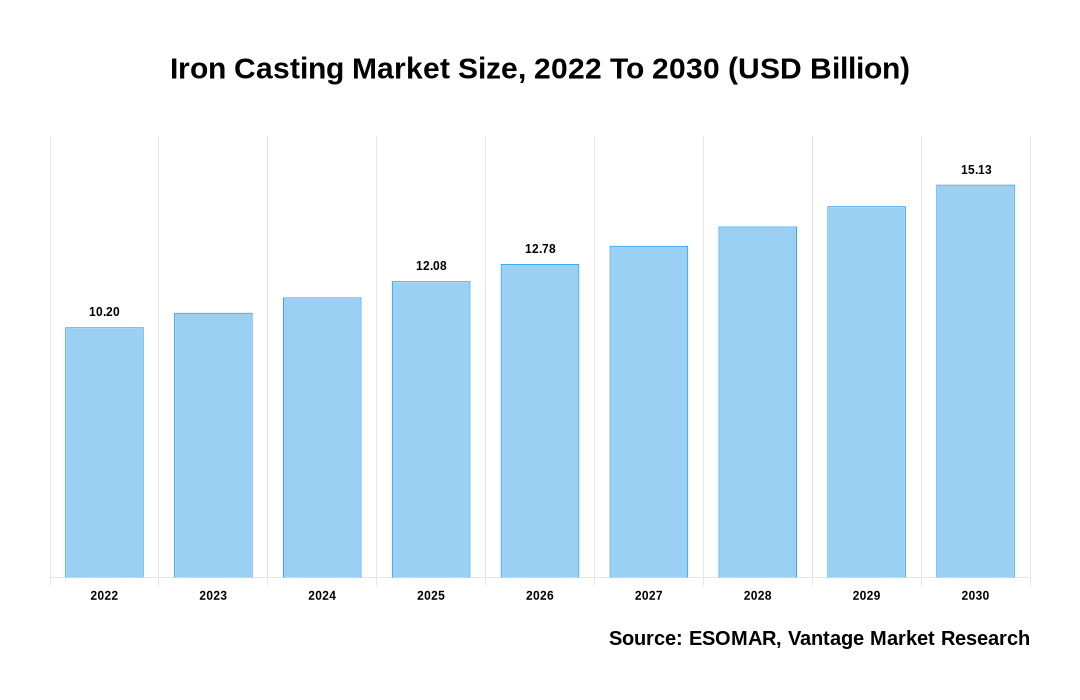Global Iron Casting Market
As stated in our extensive report; the Global Iron Casting Market accounted for USD 10.2 Billion in the year 2022 and is forecast to reach USD 15.13 Billion by 2030 at a CAGR of 5.8%.
The Iron Casting market is developing as a result of a number of factors, such as the rise in demand for dependable and long-lasting parts, economical manufacturing techniques, technical improvements, and a focus on sustainability. Automation, simulation software, and other cutting-edge technology have increased the productivity and calibre of iron casting production. Computer-aided design (CAD) is one such example. Also, businesses looking to lessen their carbon footprint and have a positive influence on the environment have realised how crucial it is to employ recycled materials in iron casting. Automobile, construction, mining, agriculture, and a number of other industries require Iron Casting. They are utilised in the production of many different parts, such as engine blocks, gearbox cases, brake parts, suspension parts, and more. The rising need for dependable and long-lasting components across a variety of sectors is anticipated to fuel market expansion in the next years.
Click To Get a Free Sample On the Research Study

Key factors influencing Iron Casting Market Growth
The growth of the global Iron Casting market can be attributable to the following:
- Increasing end-use industry demand: Demand for Iron Casting is being driven by a number of end-use industries, including the automotive, building, and industrial machinery sectors. The need for Iron Casting is projected to grow as these sectors develop and flourish.
- Urbanization and infrastructure growth: With urbanisation and infrastructure growth, there is a rising demand for building supplies, machinery, and equipment, many of which are constructed of Iron Casting. In the upcoming years, this is anticipated to fuel the demand for Iron Casting.
- Technical developments: The production process is becoming more productive and less expensive for makers of Iron Casting because to developments in technology like 3D printing and automation. The growth of the iron casting market is anticipated to be boosted by this.
- Increasing disposable income: Consumers are likely to spend more as their disposable income increases on products like cars and home appliances, which are frequently made of Iron Casting. The demand for Iron Casting in the consumer products industry is anticipated to increase as a result.
- Developing economies: The demand for Iron Casting is increasing as a result of the fast industrialization and urbanisation taking place in emerging economies like China and India. The iron casting market in the Asia-Pacific region is anticipated to increase as a result of this.
Asia Pacific Region to Lead the Market
With a sizeable portion of the global market of approximately 65%, the Asia Pacific region is the largest market for Iron Casting. This is because there are several developing nations with rapidly industrializing and urbanizing economies, including China and India. The need for Iron Casting is being driven by the expansion of the region’s construction and automotive industries. The Asia-Pacific area also has a competitive edge in the manufacture of Iron Casting because labour prices are lower and raw resources like iron ore and coal are widely available.
Conclusion
In conclusion, the market for iron casting is developing as a result of a number of factors, such as rising demand from different industries, efficient manufacturing procedures, development in technology, and a focus on sustainability. Iron Casting are utilised in a variety of applications and offer a robust and dependable option for producing huge components and complex shapes in large quantities at reasonably cheap rates. The efficiency and quality of iron casting production have increased thanks to the adoption of cutting-edge technology including computer-aided design (CAD), simulation software, and automation, making it more competitive than other manufacturing processes.
Further, for businesses looking to lower their carbon footprint and have a positive environmental impact, the utilisation of recycled materials in iron casting has grown in significance. Overall, these factors and the rising need for dependable and durable parts across numerous industries are projected to fuel the iron casting market’s growth in the years to come.
Some of the key players in the Global Iron Casting Market includes Hitachi Metals Ltd. (Japan), Liaoning Borui Machinery Co. Ltd. (Dandong Foundry) (China), Brakes India Pvt. Ltd. (India), OSCO Industries Inc. (U.S.), Chamberlin PLC (UK), Crescent Foundry (India) and others.
![[Market Research Reports] – Research Google News Blog | VMR.Biz](https://www.vmr.biz/wp-content/uploads/2022/12/logo-removebg-preview.png)











